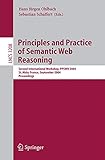Principles and Practice of Semantic Web Reasoning [electronic resource] : Second International Workshop, PPSWR 2004, St. Malo, France, September 6-10, 2004. Proceedings / edited by Hans Jürgen Ohlbach, Sebastian Schaffert.
Material type: TextSeries: Lecture Notes in Computer Science ; 3208Publisher: Berlin, Heidelberg : Springer Berlin Heidelberg, 2004Description: VII, 163 p. online resourceContent type: text Media type: computer Carrier type: online resourceISBN: 9783540301226Subject(s): Computer science | Software engineering | Information storage and retrieval systems | Information systems | Artificial intelligence | Computer Science | Information Systems Applications (incl.Internet) | Information Storage and Retrieval | Artificial Intelligence (incl. Robotics) | Mathematical Logic and Formal Languages | Software EngineeringAdditional physical formats: Printed edition:: No titleDDC classification: 005.7 LOC classification: QA76.76.A65Online resources: Click here to access online
TextSeries: Lecture Notes in Computer Science ; 3208Publisher: Berlin, Heidelberg : Springer Berlin Heidelberg, 2004Description: VII, 163 p. online resourceContent type: text Media type: computer Carrier type: online resourceISBN: 9783540301226Subject(s): Computer science | Software engineering | Information storage and retrieval systems | Information systems | Artificial intelligence | Computer Science | Information Systems Applications (incl.Internet) | Information Storage and Retrieval | Artificial Intelligence (incl. Robotics) | Mathematical Logic and Formal Languages | Software EngineeringAdditional physical formats: Printed edition:: No titleDDC classification: 005.7 LOC classification: QA76.76.A65Online resources: Click here to access online  E-BOOKS
E-BOOKS
| Current library | Home library | Call number | Materials specified | URL | Status | Date due | Barcode |
|---|---|---|---|---|---|---|---|
| IMSc Library | IMSc Library | Link to resource | Available | EBK3352 |
On Subtyping of Tree-Structured Data: A Polynomial Approach -- Towards Generic Query, Update, and Event Languages for the Semantic Web -- Data Retrieval and Evolution on the (Semantic) Web: A Deductive Approach -- Rules and Queries with Ontologies: A Unified Logical Framework -- Semantic Web Reasoning for Ontology-Based Integration of Resources -- Static Type-Checking of Datalog with Ontologies -- Reasoning About Temporal Context Using Ontology and Abductive Constraint Logic Programming -- Towards a Multi-calendar Temporal Type System for (Semantic) Web Query Languages -- Calendrical Calculations with Time Partitionings and Fuzzy Time Intervals -- DR-DEVICE: A Defeasible Logic System for the Semantic Web -- A PDDL Based Tool for Automatic Web Service Composition.
The best informal de?nition of the Semantic Web is maybe found in the May 2001Scienti?cAmericanarticle“TheSemanticWeb”(Berners-Leeetal. ),which says“TheSemanticWebisanextensionofthecurrentWebinwhichinformation is given well-de?ned meaning, better enabling computers and people to work in cooperation. ” People who work on the Semantic Web quite often base their work on the famous “semantic web tower”, a product of Tim Berners-Lee’s inspiring drawing on whiteboards. The lowest level is the level of character representation (Unicode) and the identi?cation of resources on the Web (URIs). The highest level concerns the problem of trusting information on the Web. Somewhere in the middle of the tower is the logic level. It addresses the problem of represe- ing information on the Web in a way so that inference rules can derive implicit information from explicitly stated information. The workshop “Principles and Practices of Semantic Web Reasoning” (PPSWR 2004) addressed problems on this level. It took place in September 2004 as a satellite event of the 20th Int- national Conference on Logic Programming (ICLP) in St. Malo, France. After PPSWR 2003 in Mumbai, India, it was the second workshop in this series. This book contains the articles presented at the workshop.


There are no comments on this title.